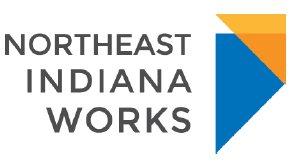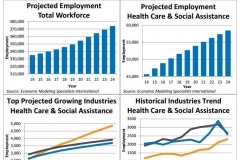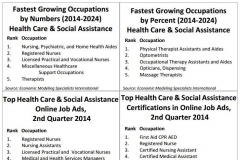
News release from Northeast Indiana Works:
Re-employed Unemployment Recipients Likely To Make Less Money, Report Shows
(January 26, 2015) – People in northeast Indiana who go on unemployment and are re-employed within a year are likely to make less money than they did before leaving the workforce, according to a January Labor Market Information report released by Northeast Indiana Works.
The trend is not exclusive to the recent recession, the report found, and workforce observers say the pattern underscores the importance of acquiring or enhancing skills that match the workforce demands of employers.
The report, based on Indiana Department of Workforce Development analysis of people who have collected unemployment insurance, looked at re-employment numbers before, during and after the recession, which economists say began in December 2007 and ended in June 2009. The analysis, which covered the period from first quarter 2004 to first quarter 2014, included people who returned from unemployment to both full- and part-time jobs and people who chose semi-retirement.
Across all industry sectors in northeast Indiana, wages on average dropped 15.8 percent before the recession for those people re-employed within a year of leaving the workforce; 19.7 during the recession; and 13.4 percent after the recession. According to the analysis, a similar trend existed statewide for the same periods: 17.2 percent before the recession; 22.9 percent during the recession; and 19.5 percent after the recession.
Gary Gatman, executive vice president for strategic initiatives at Northeast Indiana Works, said there are a number of likely reasons for the decline in pay for the re-employed, including some people opting for part-time work – sometimes because they believed they had no other options – and others choosing a modified retirement.
“Moreover,” he said, “skills are often company-specific and so people seeking re-employment may need to pursue additional training and education. We know that the more training and education people complete – while they’re either employed or unemployed – the better chances they have of securing a good-paying job. This is something northeast Indiana has been promoting heavily.”
Gatman said there are many opportunities for northeast Indiana residents to acquire new skills or enhance existing ones through WorkOne Northeast workshops and on-the-job training opportunities, as well as through programs offered by education providers throughout the region.
Average lower wages for the re-employed is a nationwide trend. One recent study by the Federal Reserve Bank of Boston said that generally “workers who experience a job displacement of any length have substantially lower wages than non-displaced workers.” That effect, the bank said, can persist for nearly two decades after a job displacement.
In northeast Indiana, the trend of decreased wages for the re-employed includes the two largest employment sectors in the region – manufacturing and health care. Some of the biggest regional wage drops, meanwhile, were recorded for re-employed people who ultimately found jobs in educational services, accommodation and food services, and retail trade.
Ellen Cutter, director of the Community Research Institute at IPFW, agreed with Gatman’s assessment of the impact of part-time work on the wages of the re-employed.
“While we don’t have numbers for the region, we know that nationally involuntary part-time employment is an issue,” she said. “There are nearly 7 million workers who are working fewer than 34 hours per week, but would prefer more hours. Although unemployment rates have improved, the number of full-time workers nationally is still 2 million shy of where it was in 2007 pre-recession.
“Some people,” she said, “simply may not be in a position to wait for a better offer. Many are in a weakened position when they find themselves unemployed. After receiving a job offer, are they able to negotiate their wages as they would if they were currently employed? Probably not.”
Cutter also noted that alternative occupations that suit the skills of the unemployed may not pay as much as the workers’ former occupations, and many re-entering the workforce lose the elevated wages they had earned from time on the job.
Kathleen Randolph, president and CEO of Northeast Indiana Works, said that as northeast Indiana strives to increase its per capita income and the quality of jobs available to people, it will be important to further study the re-employment trends in the region to ascertain the most critical factors leading to lower wages.
“At the very least,” Randolph said, “we need to strengthen existing sector partnerships and develop new ones that provide education and training pathways to high-quality jobs that are in demand by employers. We need to make sure people have access to market-relevant career development opportunities.”
Largest Wage Declines for Northeast Indiana Re-Employed
Pre-Recession
Educational Services (-46.7 percent)
Accommodation and Food Services (-43.7 percent)
Retail Trade (-38 percent)Recession
Educational Services (-44.7 percent)
Accommodation and Food Services (-39.9 percent)
Retail Trade (-39.7 percent)Post-Recession
Accommodation and Food Services (-35 percent)
Educational Services (-33.9 percent)
Retail Trade (-33.9 percent)Smallest Wage Declines for Northeast Indiana Re-Employed
Pre-Recession
Manufacturing (-5.26 percent)
Construction (-6.73 percent)
Transportation and Warehousing (-17 percent)Recession
Utilities (-9.2 percent)
Manufacturing (-11.5 percent)
Mining (-18 percent)Post-Recession
Manufacturing (-1.22 percent)
Mining (-3 percent)
Construction (-9.2 percent)
About Northeast Indiana Works
Northeast Indiana Works, the region’s workforce investment board, provides public and private financial and employment resources to businesses and individuals for education and skills training to meet the needs of regional industries. The nonprofit sets policy for how public and private funds are utilized to support talent development. It also operates and staffs the 11 county-based WorkOne Northeast career centers in the region. Individuals and companies may access resources and services by visiting or calling WorkOne in their county.




